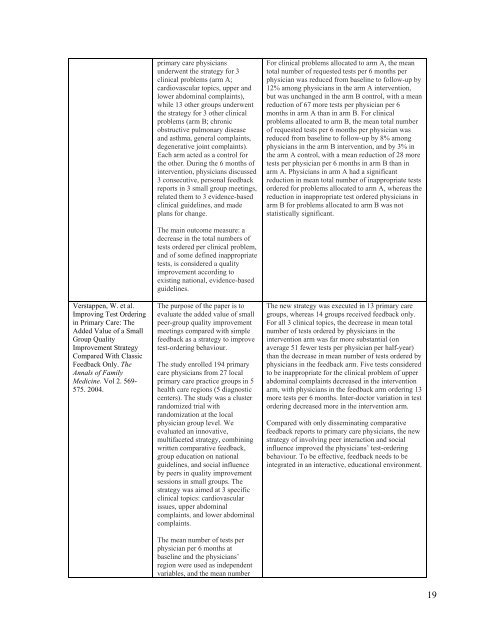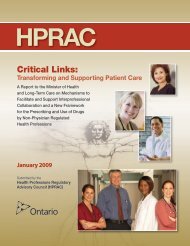Scope Of Practice Review - Health Professions Regulatory Advisory ...
Scope Of Practice Review - Health Professions Regulatory Advisory ...
Scope Of Practice Review - Health Professions Regulatory Advisory ...
You also want an ePaper? Increase the reach of your titles
YUMPU automatically turns print PDFs into web optimized ePapers that Google loves.
primary care physiciansunderwent the strategy for 3clinical problems (arm A;cardiovascular topics, upper andlower abdominal complaints),while 13 other groups underwentthe strategy for 3 other clinicalproblems (arm B; chronicobstructive pulmonary diseaseand asthma, general complaints,degenerative joint complaints).Each arm acted as a control forthe other. During the 6 months ofintervention, physicians discussed3 consecutive, personal feedbackreports in 3 small group meetings,related them to 3 evidence-basedclinical guidelines, and madeplans for change.For clinical problems allocated to arm A, the meantotal number of requested tests per 6 months perphysician was reduced from baseline to follow-up by12% among physicians in the arm A intervention,but was unchanged in the arm B control, with a meanreduction of 67 more tests per physician per 6months in arm A than in arm B. For clinicalproblems allocated to arm B, the mean total numberof requested tests per 6 months per physician wasreduced from baseline to follow-up by 8% amongphysicians in the arm B intervention, and by 3% inthe arm A control, with a mean reduction of 28 moretests per physician per 6 months in arm B than inarm A. Physicians in arm A had a significantreduction in mean total number of inappropriate testsordered for problems allocated to arm A, whereas thereduction in inappropriate test ordered physicians inarm B for problems allocated to arm B was notstatistically significant.Verstappen, W. et al.Improving Test Orderingin Primary Care: TheAdded Value of a SmallGroup QualityImprovement StrategyCompared With ClassicFeedback Only. TheAnnals of FamilyMedicine. Vol 2. 569-575. 2004.The main outcome measure: adecrease in the total numbers oftests ordered per clinical problem,and of some defined inappropriatetests, is considered a qualityimprovement according toexisting national, evidence-basedguidelines.The purpose of the paper is toevaluate the added value of smallpeer-group quality improvementmeetings compared with simplefeedback as a strategy to improvetest-ordering behaviour.The study enrolled 194 primarycare physicians from 27 localprimary care practice groups in 5health care regions (5 diagnosticcenters). The study was a clusterrandomized trial withrandomization at the localphysician group level. Weevaluated an innovative,multifaceted strategy, combiningwritten comparative feedback,group education on nationalguidelines, and social influenceby peers in quality improvementsessions in small groups. Thestrategy was aimed at 3 specificclinical topics: cardiovascularissues, upper abdominalcomplaints, and lower abdominalcomplaints.The mean number of tests perphysician per 6 months atbaseline and the physicians’region were used as independentvariables, and the mean numberThe new strategy was executed in 13 primary caregroups, whereas 14 groups received feedback only.For all 3 clinical topics, the decrease in mean totalnumber of tests ordered by physicians in theintervention arm was far more substantial (onaverage 51 fewer tests per physician per half-year)than the decrease in mean number of tests ordered byphysicians in the feedback arm. Five tests consideredto be inappropriate for the clinical problem of upperabdominal complaints decreased in the interventionarm, with physicians in the feedback arm ordering 13more tests per 6 months. Inter-doctor variation in testordering decreased more in the intervention arm.Compared with only disseminating comparativefeedback reports to primary care physicians, the newstrategy of involving peer interaction and socialinfluence improved the physicians’ test-orderingbehaviour. To be effective, feedback needs to beintegrated in an interactive, educational environment.19
















